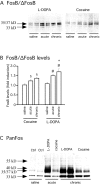cAMP response element-binding protein is required for dopamine-dependent gene expression in the intact but not the dopamine-denervated striatum
- PMID: 11739600
- PMCID: PMC4204657
- DOI: 10.1523/JNEUROSCI.21-24-09930.2001
cAMP response element-binding protein is required for dopamine-dependent gene expression in the intact but not the dopamine-denervated striatum
Abstract
The cAMP response element-binding protein (CREB) is believed to play a pivotal role in dopamine (DA) receptor-mediated nuclear signaling and neuroplasticity. Here we demonstrate that the significance of CREB for gene expression depends on the experimental paradigm. We compared the role of CREB in two different but related models: l-DOPA administration to unilaterally 6-hydroxydopamine lesioned rats, and cocaine administration to neurologically intact animals. Antisense technology was used to produce a local knockdown of CREB in the lateral caudate-putamen, a region that mediates the dyskinetic or stereotypic manifestations associated with l-DOPA or cocaine treatment, respectively. In intact rats, CREB antisense reduced both basal and cocaine-induced expression of c-Fos, FosB/DeltaFosB, and prodynorphin mRNA. In the DA-denervated striatum, CREB was not required for l-DOPA to induce these gene products, nor did CREB contribute considerably to DNA binding activity at cAMP responsive elements (CREs) and CRE-like enhancers. DeltaFosB-related proteins and JunD were the main contributors to both CRE and AP-1 DNA-protein complexes in l-DOPA-treated animals. In behavioral studies, intrastriatal CREB knockdown caused enhanced activity scores in intact control animals and exacerbated the dyskinetic effects of acute l-DOPA treatment in 6-OHDA-lesioned animals. These data demonstrate that CREB is not required for the development of l-DOPA-induced dyskinesia in hemiparkinsonian rats. Moreover, our results reveal an unexpected alteration of nuclear signaling mechanisms in the parkinsonian striatum treated with l-DOPA, where AP-1 transcription factors appear to supersede CREB in the activation of CRE-containing genes.
Figures











References
-
- Andersson M, Hilbertson A, Cenci MA. Striatal fosB expression is causally linked with l-DOPA-induced abnormal involuntary movements and the associated upregulation of striatal prodynorphin mRNA in a rat model of Parkinson's disease. Neurobiol Dis. 1999;6:461–474. - PubMed
-
- Calon F, Tahar AH, Blanchet PJ, Morissette M, Grondin R, Goulet M, Doucet JP, Robertson GS, Nestler E, Di Paolo T, Bedard PJ. Dopamine-receptor stimulation: biobehavioral and biochemical consequences. Trends Neurosci. 2000;23:S92–100. - PubMed
-
- Carlezon WA, Jr, Thome J, Olson VG, Lane-Ladd SB, Brodkin ES, Hiroi N, Duman RS, Neve RL, Nestler EJ. Regulation of cocaine reward by CREB. Science. 1998;282:2272–2275. - PubMed
-
- Cenci MA, Lee CS, Björklund A. l-DOPA-induced dyskinesia in the rat is associated with striatal overexpression of prodynorphin- and glutamic acid decarboxylase mRNA. Eur J Neurosci. 1998;10:2694–2706. - PubMed
-
- Cenci MA, Tranberg A, Andersson M, Hilbertson A. Changes in the regional and compartmental distribution of FosB- and JunB-like immunoreactivity induced in the dopamine-denervated rat striatum by acute or chronic l-DOPA treatment. Neuroscience. 1999;94:515–527. - PubMed
Publication types
MeSH terms
Substances
Grants and funding
LinkOut - more resources
Full Text Sources
Miscellaneous
